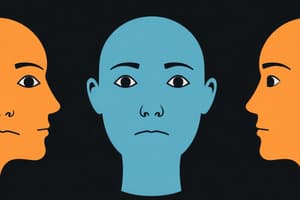Podcast
Questions and Answers
Which of the following best describes the concept of 'cathexis'?
Which of the following best describes the concept of 'cathexis'?
- The fear of tangible dangers in the external world.
- The unconscious drive towards decay and destruction.
- The investment of psychic energy in an object or person. (correct)
- A defense mechanism where one attributes their own feelings to another.
What is the primary function of anxiety in personality?
What is the primary function of anxiety in personality?
- To enable rational thought and problem-solving.
- To create a sense of detachment from reality.
- To signal a problem with personality and alert the ego of threats. (correct)
- To facilitate the expression of unconscious sexual urges.
Which defense mechanism involves attributing one's own unacceptable thoughts or feelings to others?
Which defense mechanism involves attributing one's own unacceptable thoughts or feelings to others?
- Rationalization
- Projection (correct)
- Sublimation
- Displacement
What is the primary focus of the 'id', as described in the text?
What is the primary focus of the 'id', as described in the text?
Which of the following is an example of 'displacement' as a defense mechanism?
Which of the following is an example of 'displacement' as a defense mechanism?
What is 'Thanatos' according to Freudian psychoanalytic theory?
What is 'Thanatos' according to Freudian psychoanalytic theory?
Which of the following best describes 'moral anxiety'?
Which of the following best describes 'moral anxiety'?
What is the primary function of defense mechanisms?
What is the primary function of defense mechanisms?
Which component of personality, as described by Freud, operates on the 'reality principle'?
Which component of personality, as described by Freud, operates on the 'reality principle'?
According to the provided text, what is a key characteristic of the Id?
According to the provided text, what is a key characteristic of the Id?
What does the concept of 'catharsis' refer to, according to the text provided?
What does the concept of 'catharsis' refer to, according to the text provided?
What is the underlying meaning of the concept of latent?
What is the underlying meaning of the concept of latent?
What is a 'Freudian slip' understood to be, based on the information provided?
What is a 'Freudian slip' understood to be, based on the information provided?
Which of the following is described as a storehouse of memories and thoughts easily recalled, yet not currently in our awareness?
Which of the following is described as a storehouse of memories and thoughts easily recalled, yet not currently in our awareness?
According to the content, past behavior can be seen as which of the following?
According to the content, past behavior can be seen as which of the following?
Which of the following best describes a key characteristic of clinical interviews as mentioned in the text?
Which of the following best describes a key characteristic of clinical interviews as mentioned in the text?
Flashcards
Libido (Eros)
Libido (Eros)
The instinct driving a person toward pleasurable behaviors and thoughts.
Thanatos
Thanatos
The unconscious drive toward decay, destruction, and aggression.
Cathexis
Cathexis
The investment of psychic energy in an object or person.
Anxiety
Anxiety
Signup and view all the flashcards
Defense Mechanisms
Defense Mechanisms
Signup and view all the flashcards
Projection
Projection
Signup and view all the flashcards
Sublimation
Sublimation
Signup and view all the flashcards
Repression
Repression
Signup and view all the flashcards
Trait
Trait
Signup and view all the flashcards
Flexible vs Inflexible
Flexible vs Inflexible
Signup and view all the flashcards
Personality Origins
Personality Origins
Signup and view all the flashcards
Big 5 Personality Traits
Big 5 Personality Traits
Signup and view all the flashcards
Personality Disorders
Personality Disorders
Signup and view all the flashcards
Cluster A Disorders
Cluster A Disorders
Signup and view all the flashcards
Borderline Personality Disorder
Borderline Personality Disorder
Signup and view all the flashcards
Narcissistic Personality Disorder
Narcissistic Personality Disorder
Signup and view all the flashcards
Avoidant Personality Disorder
Avoidant Personality Disorder
Signup and view all the flashcards
Obsessive Compulsive Personality Disorder
Obsessive Compulsive Personality Disorder
Signup and view all the flashcards
Inter scorer reliability
Inter scorer reliability
Signup and view all the flashcards
Ego
Ego
Signup and view all the flashcards
ID
ID
Signup and view all the flashcards
Freudian Slips
Freudian Slips
Signup and view all the flashcards
Levels of Awareness
Levels of Awareness
Signup and view all the flashcards
Catharsis
Catharsis
Signup and view all the flashcards
Past behavior prediction
Past behavior prediction
Signup and view all the flashcards
Growth Oriented Mindset
Growth Oriented Mindset
Signup and view all the flashcards
Study Notes
Psychological Introduction
- Normal behavior is statistically average, not necessarily healthy
- Abnormal behavior is outside of normal limits, often diagnosed via DMS-IV
- Personality disorders include criminal or perceived "evil" tendencies
Personality Psychology
- Personality psychology scientifically examines factors shaping an individual's personality influenced by environmental and genetic factors
- The Barnum Effect describes the tendency to accept vague statements about personality as accurate.
- The Minnesota Multiphasic Personality Inventory (MMPI) measures personality traits and mental health issues through self-report measures
- Personality assessment is used for diagnosis, counseling, education, and research
Principles of Measurement
- Reliability refers to consistency in response to a psychological assessment tool
- Validity refers to the tool's accuracy in measuring what it intends to measure
Types of Assessments
- Self-report measures involve questionnaires
- Projective techniques use ambiguous stimuli to reveal unconscious feelings; example- Thematic Apperception Test (TAT) and Rorschach Inkblot Test
- Clinical interviews gather information through direct questioning
- Behavioral observations and experience sampling involve systematic recording of behavior or samples over time
Personality Disorders
- Personality disorders represent inflexible, maladaptive behaviors that deviate from cultural norms, commonly grouped into clusters (A, B, and C)
- Cluster A includes paranoid, schizoid, and schizotypal traits; odd/eccentric characteristics
- Cluster B involves antisocial, borderline, histrionic, and narcissistic personality traits; dramatic/erratic traits
- Cluster C contains avoidant, dependent, and obsessive-compulsive traits; anxious/fearful characteristics
Extremes of Personality Continuum
- Personality traits stem from a combination of genes, temperament, and environmental factors, largely formed during childhood experiences.
- A range of personality traits exists; some are perceived as more desirable than others, with extremes being either healthy or unhealthy.
Common Personality Disorders
- Paranoid personality: extreme distrust and suspicion
- Schizoid personality: detachment from social relationships
- Schizotypal personality: discomfort in close relationships and unusual beliefs
- Antisocial personality: disregard for rights of others and rules (often criminal)
- Borderline personality: unstable relationships, emotions, and self-image
- Histrionic personality: excessive emotionality and attention-seeking behavior
- Narcissistic personality: grandiosity, need for admiration, lack of empathy
- Avoidant personality: social inhibition, feelings of inadequacy, and fear of rejection
- Dependent personality: excessive need to be cared for and submissive behavior
- Obsessive-compulsive personality: preoccupation with orderliness, perfectionism, and control
Additional Topics
- Defense mechanisms are unconscious strategies to protect the ego from anxiety caused by various external and internal stressors
- Freudian slips reflect unconscious motives or anxieties
- Anxiety arises from conflicts between the id, ego, and superego, arising from conscious/unconscious interactions and conflicts impacting self-esteem
Studying That Suits You
Use AI to generate personalized quizzes and flashcards to suit your learning preferences.




